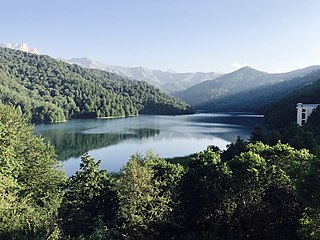Related Research Articles

A nature reserve, is a protected area of importance for flora, fauna, or features of geological or other special interest, which is reserved and managed for purposes of conservation and to provide special opportunities for study or research. They may be designated by government institutions in some countries, or by private landowners, such as charities and research institutions. Nature reserves fall into different IUCN categories depending on the level of protection afforded by local laws. Normally it is more strictly protected than a nature park. Various jurisdictions may use other terminology, such as ecological protection area or private protected area in legislation and in official titles of the reserves.

Kamchatka Krai is a federal subject of Russia. It is geographically located in the Far East region of the country, and it is administratively part of the Far Eastern Federal District. Kamchatka Krai has a population of 322,079 (2010).
Fauna of Azerbaijan or animal kingdom of Azerbaijan refers to the diversity of various types of animals, which inhabit and populate a defined ground or water area in Azerbaijan.

The environment of Azerbaijan includes a wide diversity of climates, animals, plants, and habitats.
State Reserves of Azerbaijan refers to the state reserves in Azerbaijan, which preserve the fauna, flora and their ecosystems.
National Parks of Azerbaijan are run by the Ministry of Ecology and Natural Resources in the Republic of Azerbaijan. The first national park established was Zangezur National Park in 2003. Since then a further 9 national parks have been established; the most recent being the Gizilaghaj National Park in 2018.

Ag-Gel National Park — is a national park of Azerbaijan. It was established by the decree of the President of Azerbaijan Ilham Aliyev, in an area in Ağcabədi Rayon and Beyləqan Rayon administrative districts on July 5, 2003 on the basis of the former "Ag-Gol State Reserve" and "Ag-Gol State Game Reserve" which it superseded, on a surface area of 17,924 hectares (179.24 km2).

Hirkan National Park — is a national park of Azerbaijan. It was established by the decree of the President of Azerbaijan Ilham Aliyev, in an area in Lankaran Rayon and Astara Rayon administrative districts on February 9, 2004 on the basis of the former "Hirkan State Reserve" which it superseded, on a surface area of 29,760 hectares (297.6 km2). It was enlarged by presidential decree on April 23, 2008 from 29,760 hectares (297.6 km2) to 40,358 hectares (403.58 km2).

Absheron National Park is a national park of Azerbaijan in the Caspian Hyrcanian mixed forests' ecoregion. It was established on the 8th of February 2005, by Order 622 of the President of Azerbaijan, Ilham Aliyev, on an area of 783 hectares (7.83 km2) in the administrative territory of the District of Azizbeyov in the City of Baku, on the base of Absheron State Nature Preserve.

Göygöl National Park — is a national park of Azerbaijan. It was established by the decree of the President of Azerbaijan Ilham Aliyev, in an area in Goygol Rayon administrative district on April 1, 2008 on the basis of the former "Goy Gol State Reserve" that was established in 1925 and which it superseded, on a surface area of 12,755 hectares (127.55 km2). It was enlarged from 6,739 hectares (67.39 km2) of the former state reserve to its current surface area as a national park.

IUCN protected area categories, or IUCN protected area management categories, are categories used to classify protected areas in a system developed by the International Union for the Conservation of Nature (IUCN).

The Western Sydney Parklands is an urban park system and a nature reserve located in Sydney, New South Wales, Australia. The NSW government has spent around $400 million for the park. The park is governed by the NSW National Parks and Wildlife Service and is listed under the National Parks and Wildlife Act 1974. The Parklands begin in the north in the City of Blacktown, cross the City of Fairfield, and end in the City of Liverpool.

Lagodekhi Protected Areas, also known as Lagodekhi National Park, is a pair of protected areas in the Kakheti district of Georgia: Lagodekhi Strict Nature Reserve and Lagodekhi Managed Nature Reserve. The combined area of the two is 24,451 hectares (94.41 sq mi). The reserves are located in north-eastern Georgia on the southern slopes of the Caucasus and border on Azerbaijan and Dagestan. Lagodekhi preserves a variety of rare local flora and fauna and was originally protected in 1912, under the Russian Empire, the first nature preserve in Georgia. Their ecoregion is that of the Caucasus mixed forests.

The Burabay National Park is a natural park located in the Burabay District, in Aqmola Region, Kazakhstan.

Bashkiriya National Park, covers a large contiguous forest on the southern end of the Ural Mountains. The park is an important buffer between the industrialized flatlands to the west, and the mountainous and sparsely populated Shulgan-Tash nature reserve and Altyn-Solok entomological reserve to the east and north. Bashkirya National Park lies between the Nugush River, and the southern bend of the Belaya River. The park features deep river valley cuts in a karst topography. It is known for a natural bridge across the river Kuperlya. The park is situated across three districts of the Republic of Bashkortostan.

Shantar Islands National Park covers both the terrestrial and maritime surroundings of the Shantar Islands, a group of 15 currently uninhabited islands that lie close to the coast of Khabarovsk Krai, in the Sea of Okhotsk in the Russian Far East. Most of the islands are moderately mountainous, with rugged cliffs; the highest point is 720 m. The area around the islands is an important area for marine mammals - including Steller Sea Lions, seals, and many species of cetacean - plus spawning salmon and very large colonies of birds. The park was formerly a state nature reserve, but re-established as a federal national park in 2013 with the stated purpose of protecting the habitat of vulnerable species, and supporting the scientific study and ecological tourism of the area. The Shantar Islands are located in the Tuguro-Chumikansky District of Khabarovsk Krai. The park is overseen by the Russian Ministry of Natural Resources.

Dagestan Nature Reserve is a Russian 'zapovednik' protects an area of sand dunes and ridges on the northwest coast of the Caspian Sea in the southeast of European Russia. The reserve, a wintering place for migratory birds, is the richest nature reserve in Russia in terms of the number of species - over 300 species have been recorded in the reserve, its buffer zones and subordinate reserves. The reserve is part of several "Important Bird and Biodiversity Areas" (IBAs). The Sarykum sand dune is the highest sand dune in Europe, at 262 m (860 ft). The reserve is situated in the Tarumovsky District of Dagestan.

Nenets Nature Reserve is a Russian 'zapovednik' in the northeast of European Russia on the coast of the Barents Sea and the delta of the Pechora River, about 800 km northeast of Arkhangelsk. With abundant wetlands, rivers, and sea islands, the reserve is an important point on the Atlantic migratory path for birds that winter in Western Europe and nest in the Eastern Europe and Western Siberian Tundra. Also present are large breeding grounds for the Atlantic Walrus. The reserve is situated in the Zapolyarny District of Nenets Autonomous Okrug. It was formally established in 1997, and covers and area of 313,400 ha (1,210 sq mi), of which 181,000 ha (700 sq mi) is over water.
References
| Wikimedia Commons has media related to Protected areas of Azerbaijan . |
- 1 2 "Archived copy". Archived from the original on 2015-07-22. Retrieved 2015-07-20.CS1 maint: archived copy as title (link)